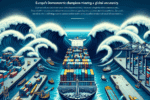Los Angeles, California — Cargo shipments from China to the United States are facing a significant decline, approaching what experts describe as a potential standstill. This shift in freight traffic reflects broader economic uncertainties and changing consumer demand patterns as the retail sector recalibrates post-pandemic.
Over the past few months, data indicate a marked decrease in containerized cargo arriving at major U.S. ports. Industry analysts point to various factors contributing to this downturn, including inflationary pressures, rising interest rates, and a general slowdown in consumer spending. Many retailers, having overstocked goods during the pandemic, are now managing surplus inventories rather than placing new orders.
Port congestion, once a hallmark of the supply chain crisis, has subsided significantly. Shipping containers that once took weeks to unload are now moving more swiftly through ports like Los Angeles and Long Beach. However, this efficiency has not translated into an increase in new shipments; instead, it underscores a troubling trend in cargo volumes.
Major shipping lines are also feeling the impact. Companies that once expanded fleets to meet the rising demand have scaled back operations and are now seeking to adjust to a new market reality. Analysts warn that the industry’s overcapacity could lead to reduced shipping rates, which may further complicate the financial viability of shipping operations.
Meanwhile, the overall economic picture remains uncertain. Recent reports indicate a shift in consumer behavior, with more individuals choosing to save rather than spend. This conservative approach may stem from fears of a recession, prompting retailers to ease back on their inventory replenishment strategies.
Some experts predict that this trend could persist if inflation continues to weigh heavily on consumer prices. As businesses adapt to changing consumer preferences, any prolonged period of decreased demand from China could have repercussions for the U.S. economy and global trade networks.
In light of these developments, industry stakeholders are closely monitoring cargo traffic trends. Shipping companies and port authorities are evaluating their strategies in anticipation of an unpredictable market landscape. Adapting efficiently to these changes will be crucial for maintaining competitive operations in the coming months.
As the situation evolves, the implications for international trade and domestic retail remain to be seen. Stakeholders are urged to remain vigilant in their assessments as they navigate through these challenging economic waters.










